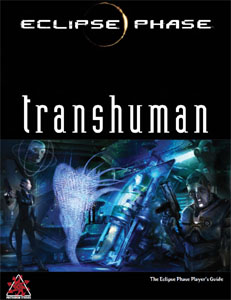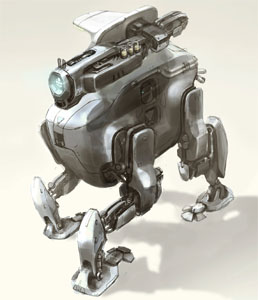 This post is a little hyper-specialized in its focus, but it was a mechanical concept that was tickling my hindbrain so I decided to just pull the trigger on it.
This post is a little hyper-specialized in its focus, but it was a mechanical concept that was tickling my hindbrain so I decided to just pull the trigger on it.
Flexbot morphs are formed from multiple, shape-adjusting modules which can flexibly reconfigure themselves into a multitude of forms: Multi-legged walkers, tentacles, hovercrafts, and so forth. In addition, their individual modules are capable of sprouting fractal-branching digits (capable of breaking into smaller digits down to micrometer scales, allowing for ultra-fine manipulation).
Eclipse Phase: Transhuman introduces a new set of rules for flexbots allowing them to incorporate specialized modules. (For example, a Beekeeper module can be used to deploy nanoswarms.) In order to support these specialized modules, Transhuman also introduces a system for calculating the characteristics of a morph formed using various configurations of specialized modules.
In order to use these rules, however, you need the stats for a basic flexbot module. Transhuman provides stats for a Yeoman module which is supposed to replace the basic flexbot morph, but it actually results in a very different stat block. So what I’ve done is to create a basic flexbot module that you can use to build a flexbot morph virtually identical to the one described in the core rulebook. I’ve also tossed in a cheap flexbot module and also something nifty called a silvershot module.
NEW FLEXBOT MODULES
A basic flexbot morph (as described in Eclipse Phase, pg. 144) contains 5 basic flexbot modules.
(Following the rules for combining flexbots, this would actually result in a morph with Durability 24 instead of the Durability 25 found in the core rulebook. But that’s the closest you can mathematically get.)
BASIC FLEXBOT MODULE
 This is the basic module found in a typical flexbot morph. In a typical configuration, one of those modules is the size of a small dog (roughly 75 centimeters high x 75 centimeters long x 25 centimeters long), but they’re capable of significantly compressing or extending their dimensions using their Shape Adjusting enhancement (see Transhuman, pg. 208).
This is the basic module found in a typical flexbot morph. In a typical configuration, one of those modules is the size of a small dog (roughly 75 centimeters high x 75 centimeters long x 25 centimeters long), but they’re capable of significantly compressing or extending their dimensions using their Shape Adjusting enhancement (see Transhuman, pg. 208).
Enhancements: Access Jacks, Basic Mesh Inserts, Cortical Stack, Cyberbrain, Fractal Digits, Mnemonic Augmentation, Modular Design, Nanoscopic Vision, Shape Adjusting
Mobility System: Walker (4/16), Hover (8/40)
Aptitude Maximum: 30
Durability: 8
Wound Threshold: 2
Advantages: Armor (4/4)
Notes: Small Size trait (Transhuman, pg. 95)
CP Cost: 4
Credit Cost: High
CHEAP FLEXBOT MODULE
Originally marketed by Starware, this cheap alternative to a typical flexbot module quickly gained an extremely negative reputation. Consumer advocacy groups leaked the full blueprints for the design in an effort to discredit Starware, but this ironically just resulted in a lot of people having access to it. Down-on-their-luck flexbots sometimes don’t have any choice but to substitute in a cheap Starware knock-off if one of their main modules is damaged.
Enhancements: Access Jacks, Basic Mesh Inserts, Cortical Stack, Cyberbrain, Mnemonic Augmentation, Modular Design, Shape Adjusting
Mobility System: Walker (4/16), Hover (4/28)
Aptitude Maximum: 20
Durability: 6
Wound Threshold: 2
Advantages: Armor (2/2)
Disadvantages: Lemon trait
Notes: Small Size trait (Transhuman, pg. 95)
CP Cost: 1
Credit Cost: Moderate
SILVERSHOT MODULE
 Silvershot modules are designed with specialized, multi-channel connections using superconducting material to synchronize high-speed, cross-modular communication through massive redundancy. A flexbot formed entirely from silvershot modules can move like quicksilver, although the advantage debilitates rapidly if non-silvershot modules are introduced.
Silvershot modules are designed with specialized, multi-channel connections using superconducting material to synchronize high-speed, cross-modular communication through massive redundancy. A flexbot formed entirely from silvershot modules can move like quicksilver, although the advantage debilitates rapidly if non-silvershot modules are introduced.
Enhancements: Access Jacks, Basic Mesh Inserts, Cortical Stack, Cyberbrain, Mnemonic Augmentation, Modular Design, Shape Adjusting
Mobility System: Walker (4/16), Vectored Thrust (8/40)
Aptitude Maximum: 30
Speed Modifier: +1 (Reflex Boosters)
Durability: 8
Wound Threshold: 2
Advantages: REF +10, Armor (4/4), Reflex Boosters
Notes: Small Size trait (Transhuman, pg. 95)
CP Cost: 8
Credit Cost: High (minimum 10,000)
COMBINING FLEXBOT MODULES
Unless noted otherwise, only physically attached modules should be considered when combining the modules of a flexbot into a flexbot morph’s stats.
Enhancements: In general, the flexbot morph is considered to have all of the enhancements and traits available to their individual modules. The exception would be any enhancement or trait that would require the entire morph to be augmented (unless, of course, all of the flexbot’s modules possess the enhancement or trait). (For example, a chameleon skin would only cloak the module possessing it.)
Mobility System: For each module which lacks a specific mobility system, the movement rate of the morph with that mobility is halved. (This penalty is cumulative for each module which lacks the mobility system.)
 Flexbot modules can reshape themselves to possess any mobility system based on purely mechanical principles (hopper, hover, roller, rotorcraft, snake, submarine, tracked, walker, wheeled, winged). A module cannot have more than two mobility systems shaped at a time. Assume shaped mobility systems have a movement rate of 4 meters.
Flexbot modules can reshape themselves to possess any mobility system based on purely mechanical principles (hopper, hover, roller, rotorcraft, snake, submarine, tracked, walker, wheeled, winged). A module cannot have more than two mobility systems shaped at a time. Assume shaped mobility systems have a movement rate of 4 meters.
Aptitude Maximum: Use the highest maximum available for each aptitude.
Speed Modifier: Flexbots use the Speed of its slowest module.
Durability: Take the highest Durability among the flexbot’s modules and add half the Durability (round up) of each additional module. Calculate the morph’s Wound Threshold (Durability ÷ 5) and Death Rating (Durability x 2) normally based on the morph’s total Durability.
- Damage: Damage is assumed to be evenly divided between a flexbot’s modules. (As an optional rule, determine which specific module was hit and apply the damage accordingly. This would only become important if a specific module separates from the flexbot or if that module is disabled, in which case the flexbot would lose any enhancements or traits specific to that module.)
Advantages/Disadvantages: As with enhancements, a flexbot morph is considered to have all the advantages and disadvantages possessed by their individual modules.
- Ability Scores: Flexbots use the highest bonus for each aptitude. Multiple bonuses to the same aptitude from different modules do not stack.
- Armor: A flexbot’s Armor Value is equal to the average Armor Value of its modules (round up).
- Individual flexbot modules count as a small target (-10 modifier to hit in combat)
This is a quick reference. Refer to Transhuman (pg. 203-206) for the complete rules.












@Justin,
This game system looks like it has some interesting ideas. How many rule books and supplements does it require to play? It seems fairly involved, is it time consuming to process all the reading when learning the game?
Justin,
To us modern unbelievers, high technology will seem supernatural, and supernatural will seem like high technology. In your illustrations, the more advanced you flexbots are, the more Lovecraftian they appear.
@ Brooser Bear,
LoL! I thought those illustrations reminded me of something by Vincent D. Fate, on a cover of an old Analog or Galaxy mag, circa 1960! The high base color contrasts, and the ovoids and missing holes in the forms. I’ve got piles of those mags from earlier than that, too.
@Neal: The game comes fully loaded with just the core rulebook. I’ve just recently finished reading all of the supplements for the game (and they’re great), but the first fifteen sessions I ran were entirely out of the core rulebook and I never felt any lack.
One of the great things about the game is that Posthuman Studios licenses the whole thing under a non-commercial Creative Commons license. Which means you can legally download the PDFs for free and check the books out before you buy. (You can find links here.)
Although the game also comes with a specific setting, I’ll also note that it also functions great as a transhuman kitchen sink: If you’re looking to run anything like Vernor Vinge, Ken MacLeod, Charles Stross, Iain Banks, or Richard K. Morgan, Eclipse Phase is going to give you what you need.
@Brooser Bear: Interesting impression. The illustrations are concept art from Sean Yoo and weren’t specifically drawn for Eclipse Phase, but there is a heavy Mythos-like horror element to EP.
@ Justin,
I followed your link to Eclipse Phase PDFs, and downloaded all of them. Looking through them, they seem quite elaborate, and interesting! It’s not my usual style of game, but maybe I can broaden my repertoire, at least get some interesting ideas.
You mentioned to Brooser Bear that this game had a “heavy Mythos-like horror element” to it. They make mention of that as a theme. I haven’t encountered that before: A combination of themes from science fiction, post-apocalyptic fiction, combined with horror (Lovecraftian, and others). If they can make it work, then it’s worth checking out.
These PDFs were all available as free downloads, under the “Creative Commons,” open gaming license, which is pretty unusual. If we like the stuff, they encourage us to buy the books, which seems more than fair.
This may sound hopelessly behind the times, but can you explain how Creative Commons, open-gaming licenses, etc, are supposed to work to sell products? What are the variations on these? I’ve looked up some of this stuff, and couldn’t identify how they differed from each other, and why some people object to different open systems. Did they come about just because WotC and others found that they could sell core rule books, but adventures weren’t generating enough product? I read something like that a few times, and wasn’t sure how a third party company could make money, if the primary company was losing it on adventures. Did any of this have anything to do with the d20 Collapse? I seem to recall you mentioned in one of your old articles that you, yourself got hammered in that collapse, when WotC reneged on promises they weren’t changing their system, and you and 3rd parties invested cash into putting out adventures… and got pounded for it.
Are all these related, or totally separate issues? That whole d20 Collapse is very old hat to most, but I wasn’t around for it, and it’s still a mystery as to what exactly happened, for me.